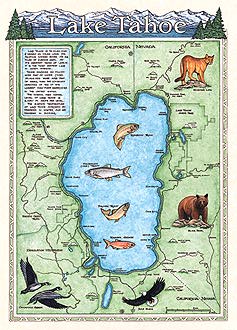

Perhaps no feature of the Sierra landscape has suffered under such a succession of names as the body of water we know today as Lake Tahoe. During the 140 years since John C. Fremont's first sighting of the lake on Valentine's Day, 1844, the big blue of this inland sea has been blessed popularly -- if not officially -- with seven different names, and as many more have been publically suggested (same with editorial tongue firmly in cheek) as alternative appellations.
The protocol of wilderness exploration dictates that discoverers have the right of naming their discoveries. In keeping with such etiquette, the lake is properly known as "Lake Bonpland", the name given to it by Fremont in honor of Aime Jacques Alexandre, the French botanist who accompanied the van Humboldt party on an earlier expedition west.
In the decade which followed Fremont's discovery, the designation "Bonpland" was favored in publications appearing on the Continent. However, the map drawn by Charles Preuss, cartographer for Captain Fremont's party, notes it simply as "Mountain Lake". In those days, few found themselves in a position to care.

Those who did care found themselves further confused by Baker's 1855 "Map af the Mining Regions", which showed the lake as "Maheon". Bartlett's "Guide", another source of the day, referred to "Big Truckee Lake", with yet another casually-placed cognomen burdening the pristine alpine paradise.
In March of 1853, California's Surveyor General, W.M. Eddy, had initiated the use of what would 17 years later become the"legal" name of the lake -- "Bigler". Yet from the start this name was destined to meet with widespread disfavor, with its most active opponents suggesting that John Bigler, the former democratic governor of California for whom the lake had been named, was less than worthy of such an honor.
Controversy over Bigler's merit as a namesake waxed hot when the outbreak of the Civil War led to charges that he entertained Confederate sympathies. Several substitute names were promptly offered up. The Unionist party mounted an unsuccessful lobbying effort in April of 1861 to rechristen the lake with the exotic "Tua Tulia". Fanning the foolishness the following year, the "Sacramento Union" suggested "Largo Bergler" as a more suitable name, "as it wauld stand as a punishing illusion to the bibulous habits of 'Honest John' Bigler when he was governor of the State"
In February of 1862, public sentiment against Bigler found expression in the form of an Interior Department map brought out under the direction of William Henry Knight, the department's chief cartographer. Knight enlisted the linguistic skills of Dr. Henry DeGroot, a "Sacramento Union" correspondent whose efforts to communicate with Washoe Indians had familiarized him with the rudiments of their dialect. "Ta-hoe", according to Dr. DeGroot, was translated 'Big Water" or "Water in a high place". And so, in the name of superior aesthetics, the name by which the lake is known today was established in the white man's vocabulary.
However, the controversy raged on, refusing to be silenced even by the passage of a bill in the California State Legislature on February 10, 1870, giving legal status to Eddy's original designation of "Bigler". Various vassals of the Fourth Estate continued to offer their suggestions as to a more suitable epithet, among them fledgling correspondent Mark Twain, then connected with Virginia City's "Territorial Enterprise". Twain found himself drawn irresistibly into the fray, occasioning to comment that "Ta-hoe", in the dialect of the Digger and "Pi-ute" (sic) tribes meant "grasshopper soup", which, he contended, was among their delicacies.
In light of public sentiment and popular usage, it is amazing that the name "Bigler" continued as a legal geographical designation until July 18, 1945 when a bill was adopted in the California State Legislature officially changing the name to "Lake Tahoe".
In addition to its impressive cavalcade of cognomens, this mile-high marvel has acquired several nicknames, including "Lake of the Sky" and "Jewel of the Sierras". But for all the variety of its names, running the gamut from complimentary to condescending, the notive population's original appellative serves best, and seems most likely to endure.
STORY: by Carol Van Etten
TAHOE MAP: by Mona Schulte

